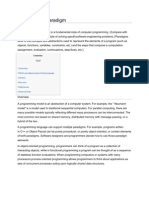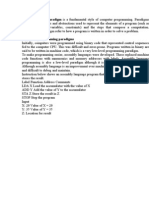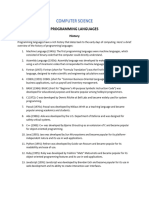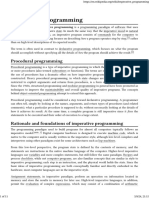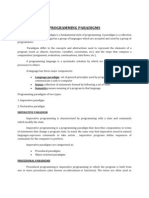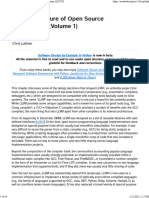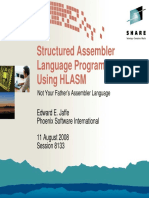0 ratings0% found this document useful (0 votes)
52 viewsModule 5 - Reading6 - StructuredProgramming
Structured programming is a programming paradigm that emerged in the 1960s to improve program clarity and quality. It makes extensive use of subroutines, blocks, and loops like for and while, rather than using simple jumps like goto statements. The structured program theorem proved that programs can be expressed using just three control structures: sequence, selection, and iteration. This provided a theoretical basis for structured programming and bolstered languages with suitable control structures like ALGOL. While goto is now rarely used, modern languages still allow some deviations from pure structured programming through constructs like early exits from functions and loops.
Uploaded by
Christopher AdvinculaCopyright
© © All Rights Reserved
Available Formats
Download as DOCX, PDF, TXT or read online on Scribd
0 ratings0% found this document useful (0 votes)
52 viewsModule 5 - Reading6 - StructuredProgramming
Structured programming is a programming paradigm that emerged in the 1960s to improve program clarity and quality. It makes extensive use of subroutines, blocks, and loops like for and while, rather than using simple jumps like goto statements. The structured program theorem proved that programs can be expressed using just three control structures: sequence, selection, and iteration. This provided a theoretical basis for structured programming and bolstered languages with suitable control structures like ALGOL. While goto is now rarely used, modern languages still allow some deviations from pure structured programming through constructs like early exits from functions and loops.
Uploaded by
Christopher AdvinculaCopyright
© © All Rights Reserved
Available Formats
Download as DOCX, PDF, TXT or read online on Scribd
You are on page 1/ 11
Reading: Structured Programming
Structured programming is a programming paradigm
aimed at improving the clarity, quality, and development time
of a computer program by making extensive use of
subroutines, block structures and for and while loops—in
contrast to using simple tests and jumps such as the goto
statement which could lead to “spaghetti code” which is
difficult both to follow and to maintain
It emerged in the 1960s—particularly from a famous letter,
Go To Statement Considered Harmful.— and was bolstered
theoretically by the structured program theorem, and
practically by the emergence of languages such as ALGOL
with suitably rich control structures.
Control structures
Following the structured program theorem, all programs are
seen as composed of three control structures:
• “Sequence”; ordered statements or subroutines executed
in sequence.
• “Selection”; one or a number of statements is executed
depending on the state of the program. This is usually
expressed with keywords such as if..then..else..endif.
• “Iteration”; a statement or block is executed until the
program reaches a certain state, or operations have
been applied to every element of a collection. This is
usually expressed with keywords such as while, repeat, for
or do..until. Often it is recommended that each loop
should only have one entry point (and in the original
structural programming, also only one exit point, and a
few languages enforce this).
Graphical representations of the three basic patterns using NS diagrams
(blue) and flow charts (green).
Subroutines
Subroutines; callable units such as procedures, functions,
methods, or subprograms are used to allow a sequence to
be referred to by a single statement.
Blocks
Blocks are used to enable groups of statements to be
treated as if they were one statement. Block-structured
languages have a syntax for enclosing structures in some
formal way, such as an if-statement bracketed by if..fi as in
ALGOL 68, or a code section bracketed byBEGIN..END, as in
PL/I, whitespace indentation as in Python – or the curly
braces {...} of C and many later languages.
Structured programming languages
It is possible to do structured programming in any
programming language, though it is preferable to use
something like a procedural programming language. Some
of the languages initially used for structured programming
include: ALGOL, Pascal, PL/I and Ada—but most new
procedural programming languages since that time have
included features to encourage structured programming, and
sometimes deliberately left out features—notably GOTO—in
an effort to make unstructured programming more difficult.
Structured programming (sometimes known as modular
programming) is a subset of procedural programming that
enforces a logical structure on the program being written to
make it more efficient and easier to understand and modify.
History
Theoretical foundation
The structured program theorem provides the theoretical
basis of structured programming. It states that three ways of
combining programs—sequencing, selection, and iteration—
are sufficient to express any computable function. This
observation did not originate with the structured
programming movement; these structures are sufficient to
describe the instruction cycle of a central processing unit, as
well as the operation of a Turing machine. Therefore a
processor is always executing a “structured program” in this
sense, even if the instructions it reads from memory are not
part of a structured program. However, authors usually credit
the result to a 1966 paper by Böhm and Jacopini, possibly
because Dijkstra cited this paper himself. The structured
program theorem does not address how to write and analyze
a usefully structured program. These issues were addressed
during the late 1960s and early 1970s, with major
contributions by Dijkstra, Robert W. Floyd, Tony Hoare, Ole-
Johan Dahl, and David Gries.
Debate
P. J. Plauger, an early adopter of structured programming,
described his reaction to the structured program theorem:
Us converts waved this interesting bit of news under the
noses of the unreconstructed assembly-language
programmers who kept trotting forth twisty bits of logic and
saying, ‘I betcha can’t structure this.’ Neither the proof by
Böhm and Jacopini nor our repeated successes at writing
structured code brought them around one day sooner than
they were ready to convince themselves.
Donald Knuth accepted the principle that programs must be
written with provability in mind, but he disagreed (and still
disagrees) with abolishing the GOTO statement. In his 1974
paper, “Structured Programming with Goto Statements”, he
gave examples where he believed that a direct jump leads to
clearer and more efficient code without sacrificing provability.
Knuth proposed a looser structural constraint: It should be
possible to draw a program’s flow chart with all forward
branches on the left, all backward branches on the right, and
no branches crossing each other. Many of those
knowledgeable in compilers and graph theory have
advocated allowing only reducible flow graphs.
Structured programming theorists gained a major ally in the
1970s after IBM researcher Harlan Mills applied his
interpretation of structured programming theory to the
development of an indexing system for the New York Times
research file. The project was a great engineering success,
and managers at other companies cited it in support of
adopting structured programming, although Dijkstra criticized
the ways that Mills’s interpretation differed from the
published work.
As late as 1987 it was still possible to raise the question of
structured programming in a computer science journal.
Dijkstra did so in that year with a letter, “GOTO considered
harmful.” Numerous objections followed, including a
response from Frank Rubin that sharply criticized both
Dijkstra and the concessions other writers made when
responding to him.
Outcome
By the end of the 20th century nearly all computer scientists
were convinced that it is useful to learn and apply the
concepts of structured programming. High-level
programming languages that originally lacked programming
structures, such as FORTRAN, COBOL, and BASIC, now
have them.
Common deviations
While goto has now largely been replaced by the structured
constructs of selection (if/then/else) and repetition (while and
for), few languages are purely structured. The most common
deviation, found in many languages, is the use of a return
statement for early exit from a subroutine. This results in
multiple exit points, instead of the single exit point required
by structured programming. There are other constructions to
handle cases that are awkward in purely structured
programming.
Early exit
The most common deviation from structured programming is
early exit from a function or loop. At the level of functions,
this is a return statement. At the level of loops, this is a break
statement (terminate the loop) or continue statement
(terminate the current iteration, proceed with next iteration).
In structured programming, these can be replicated by
adding additional branches or test, but for returns from
nested code this can add significant complexity. C is an early
and prominent example of these constructs. Some newer
languages also have “labeled breaks”, which allow breaking
out of more than just the innermost loop. Exceptions also
allow early exit, but have further consequences, and thus are
treated below.
Multiple exits can arise for a variety of reasons, most often
either that the subroutine has no more work to do (if
returning a value, it has completed the calculation), or has
encountered “exceptional” circumstances that prevent it from
continuing, hence needing exception handling.
The most common problem in early exit is that cleanup or
final statements are not executed – for example, allocated
memory is not unallocated, or open files are not closed,
causing memory leaks or resource leaks. These must be
done at each return site, which is brittle and can easily result
in bugs. For instance, in later development, a return
statement could be overlooked by a developer, and an
action which should be performed at the end of a subroutine
(e.g., a trace statement) might not be performed in all cases.
Languages without a return statement, such as standard
Pascal don’t have this problem.
Most modern languages provide language-level support to
prevent such leaks; see detailed discussion at resource
management. Most commonly this is done via unwind
protection, which ensures that certain code is guaranteed to
be run when execution exits a block; this is a structured
alternative to having a cleanup block and a goto. This is most
often known as try...finally, and considered a part of exception
handling. Various techniques exist to encapsulate resource
management. An alternative approach, found primarily in C+
+, isResource Acquisition Is Initialization, which uses normal
stack unwinding (variable deallocation) at function exit to call
destructors on local variables to deallocate resources.
Kent Beck, Martin Fowler and co-authors have argued in
their refactoring books that nested conditionals may be
harder to understand than a certain type of flatter structure
using multiple exits predicated by guard clauses. Their 2009
book flatly states that “one exit point is really not a useful
rule. Clarity is the key principle: If the method is clearer with
one exit point, use one exit point; otherwise don’t”. They
offer a cookbook solution for transforming a function
consisting only of nested conditionals into a sequence of
guarded return (or throw) statements, followed by a single
unguarded block, which is intended to contain the code for
the common case, while the guarded statements are
supposed to deal with the less common ones (or with
errors). Herb Sutter and Andrei Alexandrescu also argue in
their 2004 C++ tips book that the single-exit point is an
obsolete requirement.
In his 2004 textbook, David Watt writes that “single-entry
multi-exit control flows are often desirable”. Using Tennent’s
framework notion of sequencer, Watt uniformly describes the
control flow constructs found in contemporary programming
languages and attempts to explain why certain types of
sequencers are preferable to others in the context of multi-
exit control flows. Watt writes that unrestricted gotos (jump
sequencers) are a bad because the destination of the jump
is not self-explanatory to the reader of a program until the
reader finds and examines the actual label or address that is
the target of the jump. In contrast, Watt argues that the
conceptual intent of a return sequencer is clear from its own
context, without having to examine its destination. Watt
writes that a class of sequencers known as escape
sequencers, defined as “sequencer that terminates
execution of a textually enclosing command or procedure”,
encompasses both breaks from loops (including multi-level
breaks) and return statements. Watt also notes that while
jump sequencers (gotos) have been somewhat restricted in
languages like C, where the target must be an inside the
local block or an encompassing outer block, that restriction
alone is not sufficient to make the intent of gotos in C self-
describing and so they can still produce “spaghetti code”.
Watt also examines how exception sequencers differ from
escape and jump sequencers; this is explained in the next
section of this article.
In contrast to the above, Bertrand Meyer wrote in his 2009
textbook that instructions like break and continue “are just the
old goto in sheep’s clothing” and strongly advised against
their use.
Exception handling
Based on the coding error from the Ariane 501 disaster,
software developer Jim Bonang argues that any exceptions
thrown from a function violate the single-exit paradigm, and
propose that all inter-procedural exceptions should be
forbidden. In C++ syntax, this is done by declaring all
function signatures as throw() Bonang proposes that all
single-exit conforming C++ should be written along the lines
of:
bool myCheck1() throw()
{
bool success = false;
try {
// do something that may throw exceptions
if(myCheck2() == false) {
throw SomeInternalException();
}
// other code similar to the above
success = true;
}
catch(...) { // all exceptions caught and logged
}
return success;
}
Peter Ritchie also notes that, in principle, even a single throw
right before the return in a function constitutes a violation of
the single-exit principle, but argues that Dijkstra’s rules were
written in a time before exception handling became a
paradigm in programming languages, so he proposes to
allow any number of throw points in addition to a single
return point. He notes that solutions which wrap exceptions
for the sake of creating a single-exit have higher nesting
depth and thus are more difficult to comprehend, and even
accuses those who propose to apply such solutions to
programming languages which support exceptions of
engaging in cargo cult thinking.
David Watt also analyzes exception handling in the
framework of sequencers (introduced in this article in the
previous section on early exits.) Watt notes that an abnormal
situation (generally exemplified with arithmetic overflows or
input/output failures like file not found) is a kind of error that
“is detected in some low-level program unit, but [for which] a
handler is more naturally located in a high-level program
unit.” For example, a program might contain several calls to
read files, but the action to perform when a file is not found
depends on the meaning (purpose) of the file in question to
the program and thus a handling routine for this abnormal
situation cannot be located in low-level system code. Watts
further notes that introducing status flags testing in the caller,
as single-exit structured programming or even (multi-exit)
return sequencers would entail, results in a situation where
“the application code tends to get cluttered by tests of status
flags” and that “the programmer might forgetfully or lazily
omit to test a status flag. In fact, abnormal situations
represented by status flags are by default ignored!” He notes
that in contrast to status flags testing, exceptions have the
opposite default behavior, causing the program to terminate
unless the programmer explicitly deals with the exception in
some way, possibly by adding code to willfully ignore it.
Based on these arguments, Watt concludes that jump
sequencers or escape sequencers (discussed in the
previous section) aren’t as suitable as a dedicated exception
sequencer with the semantics discussed above.
The textbook by Louden and Lambert emphasizes that
exception handling differs from structured programming
constructs like while loops because the transfer of control “is
set up at a different point in the program than that where the
actual transfer takes place. At the point where the transfer
actually occurs, there may be no syntactic indication that
control will in fact be transferred.” Computer science
professor Arvind Kumar Bansal also notes that in languages
which implement exception handling, even control structures
like for, which have the single-exit property in absence of
exceptions, no longer have it in presence of exceptions,
because an exception can prematurely cause an early exit in
any part of the control structure; for instance if init() throws an
exception in for (init(); check(); increm()), then the usual exit point
after check() is not reached. Citing multiple prior studies by
others (1999-2004) and their own results, Westley Weimer
and George Necula wrote that a significant problem with
exceptions is that they “create hidden control-flow paths that
are difficult for programmers to reason about.”
The necessity to limit code to single-exit points appears in
some contemporary programming environments focused on
parallel computing, such as OpenMP. The various parallel
constructs from OpenMP, like parallel do, do not allow early
exits from inside to the outside of the parallel construct; this
restriction includes all manner of exits, from break to C++
exceptions, but all of these are permitted inside the parallel
construct if the jump target is also inside it.
Multiple entry
More rarely, subprograms allow multiple entry. This is most
commonly only re-entry into a coroutine (or
generator/semicoroutine), where a subprogram yields control
(and possibly a value), but can then be resumed where it left
off. There are a number of common uses of such
programming, notably for streams (particularly input/output),
state machines, and concurrency. From a code execution
point of view, yielding from a coroutine is closer to structured
programming than returning from a subroutine, as the
subprogram has not actually terminated, and will continue
when called again—it is not an early exit. However,
coroutines mean that multiple subprograms have execution
state – rather than a single call stack of subroutines—and
thus introduce a different form of complexity.
It is very rare for subprograms to allow entry to an arbitrary
position in the subprogram, as in this case the program state
(such as variable values) is uninitialized or ambiguous, and
this is very similar to a goto.
State machines
Some programs, particularly parsers and communications
protocols, have a number of states that follow each other in
a way that is not easily reduced to the basic structures, and
some programmers (including Knuth) implement the state-
changes with a jump to the new state. This type of state-
switching is often used in the Linux kernel.
However, it is possible to structure these systems by making
each state-change a separate subprogram and using a
variable to indicate the active state (see trampoline).
Alternatively, these can be implemented via coroutines,
which dispense with the trampoline.
You might also like
- Nonsequential and Distributed Programming With Go: Christian MaurerNo ratings yetNonsequential and Distributed Programming With Go: Christian Maurer419 pages
- Project Report Wheather Forecast Web ApplicationNo ratings yetProject Report Wheather Forecast Web Application49 pages
- 1.A Review of Programming Paradigms Throughout The History - With A Suggestion Toward A Future Approach100% (1)1.A Review of Programming Paradigms Throughout The History - With A Suggestion Toward A Future Approach87 pages
- Abstraction (Computer Science) - WikipediaNo ratings yetAbstraction (Computer Science) - Wikipedia13 pages
- 1.02 - 2reading - Imperative Programming - WikipediaNo ratings yet1.02 - 2reading - Imperative Programming - Wikipedia3 pages
- Nonsequential and Distributed Programming with Go. Christian Maurer - The ebook in PDF format is ready for immediate access100% (1)Nonsequential and Distributed Programming with Go. Christian Maurer - The ebook in PDF format is ready for immediate access72 pages
- C5 OOP ObjectOrientedProgramming STUD FTNo ratings yetC5 OOP ObjectOrientedProgramming STUD FT11 pages
- Effects Without Monads: Non-Determinism Back To The Meta LanguageNo ratings yetEffects Without Monads: Non-Determinism Back To The Meta Language26 pages
- Go To Statement Considered Harmful SummaryNo ratings yetGo To Statement Considered Harmful Summary4 pages
- Test-Driven Development: Software Engineering Application Software SystemNo ratings yetTest-Driven Development: Software Engineering Application Software System26 pages
- Theory Introduction To Programming Languages100% (2)Theory Introduction To Programming Languages233 pages
- Download Complete Nonsequential and Distributed Programming with Go. Christian Maurer PDF for All Chapters100% (3)Download Complete Nonsequential and Distributed Programming with Go. Christian Maurer PDF for All Chapters37 pages
- Structured and Unstructured Maintenance With Example0% (1)Structured and Unstructured Maintenance With Example9 pages
- Principles_of_software_engineering_and_dNo ratings yetPrinciples_of_software_engineering_and_d1 page
- Introduction To Theory of Programming Languages100% (1)Introduction To Theory of Programming Languages233 pages
- Instant Ebooks Textbook Introduction To Compiler Design 2nd Edition Torben Ægidius Mogensen (Auth.) Download All Chapters100% (4)Instant Ebooks Textbook Introduction To Compiler Design 2nd Edition Torben Ægidius Mogensen (Auth.) Download All Chapters62 pages
- Progress in Programming Languages: Kim@cs - Williams.edu&No ratings yetProgress in Programming Languages: Kim@cs - Williams.edu&3 pages
- Parallel Programming: Homework Number 5 ObjectiveNo ratings yetParallel Programming: Homework Number 5 Objective6 pages
- Subject Name: Principles of Programming LanguagesNo ratings yetSubject Name: Principles of Programming Languages6 pages
- The Architecture of Open Source Applications (Volume 1) LLVMNo ratings yetThe Architecture of Open Source Applications (Volume 1) LLVM16 pages
- Applying Case-Based Reasoning To Code Understanding and GenerationNo ratings yetApplying Case-Based Reasoning To Code Understanding and Generation14 pages
- Lovely Professional: Submitted To: - Submitted By:-Neha Malhotra Satnam SinghNo ratings yetLovely Professional: Submitted To: - Submitted By:-Neha Malhotra Satnam Singh15 pages
- Readability of Source Code: Chess Algorithms As An ExampleNo ratings yetReadability of Source Code: Chess Algorithms As An Example4 pages
- Comparison of Programming Paradigms - Wikipedia The Free EncyclNo ratings yetComparison of Programming Paradigms - Wikipedia The Free Encycl6 pages
- Algorithm for Developing a Programming LanguageNo ratings yetAlgorithm for Developing a Programming Language4 pages
- DESIGN AND IMPLEMENTATION OF THE MOREHEAD-AZALEA COMPILER (MAC)No ratings yetDESIGN AND IMPLEMENTATION OF THE MOREHEAD-AZALEA COMPILER (MAC)14 pages
- An Introduction to Functional Programming Through Lambda CalculusFrom EverandAn Introduction to Functional Programming Through Lambda CalculusNo ratings yet
- G.R. No. 163766 June 22, 2006 Republic of The Philippines, Petitioner, CANDY MAKER, INC., As Represented by Its President, ONG YEE SEE, RespondentNo ratings yetG.R. No. 163766 June 22, 2006 Republic of The Philippines, Petitioner, CANDY MAKER, INC., As Represented by Its President, ONG YEE SEE, Respondent9 pages
- Chapter-1 - Digital Systems and Binary Numbers PDF0% (1)Chapter-1 - Digital Systems and Binary Numbers PDF102 pages
- Module 5 - Reading4 - InformationPrivacyNo ratings yetModule 5 - Reading4 - InformationPrivacy10 pages
- Class Standing: Christ The King Collegecalbayog Citycomputation SheetNo ratings yetClass Standing: Christ The King Collegecalbayog Citycomputation Sheet9 pages
- Module 5 - Reading1 - SystemDevelopmentNo ratings yetModule 5 - Reading1 - SystemDevelopment26 pages
- Module 5 - Reading5 - SystemDevelopmentNo ratings yetModule 5 - Reading5 - SystemDevelopment13 pages
- Module 5 - Reading7 - SoftwareDevelopmentProcessNo ratings yetModule 5 - Reading7 - SoftwareDevelopmentProcess15 pages
- Module 6 - Reading3 - TelecommunicationNetworkNo ratings yetModule 6 - Reading3 - TelecommunicationNetwork5 pages
- Module 6 - Reading2 - SecurityandSocialIssuesNo ratings yetModule 6 - Reading2 - SecurityandSocialIssues8 pages
- Module 6 - Reading1 - NetworksandTelecommunicationsNo ratings yetModule 6 - Reading1 - NetworksandTelecommunications8 pages
- Module 4 - Reading5 - UniformResourceLocatorNo ratings yetModule 4 - Reading5 - UniformResourceLocator7 pages
- 20 CSEC - Past Year Paper Solution 2019-2020 Sem 1 CE/CZ 1005 Digital LogicNo ratings yet20 CSEC - Past Year Paper Solution 2019-2020 Sem 1 CE/CZ 1005 Digital Logic7 pages
- ICS 431-Ch14-File System ImplementationNo ratings yetICS 431-Ch14-File System Implementation29 pages
- Lab 4 MAINTAINING AND TROUBLESHOOTING COMPUTER SYSTEM AND PERIPHERAL COMPONENTSNo ratings yetLab 4 MAINTAINING AND TROUBLESHOOTING COMPUTER SYSTEM AND PERIPHERAL COMPONENTS18 pages
- SH35-0050-2 Document Composition Facility Generalized Markup Language Implementation Guide Rel 3 Mar85No ratings yetSH35-0050-2 Document Composition Facility Generalized Markup Language Implementation Guide Rel 3 Mar85272 pages
- Benchmarking O-RAN Performance: White PaperNo ratings yetBenchmarking O-RAN Performance: White Paper7 pages
- Handling Missing Value in Decision Tree Algorithm PDFNo ratings yetHandling Missing Value in Decision Tree Algorithm PDF6 pages
- Communications in Computer and Information Science 895: Editorial BoardNo ratings yetCommunications in Computer and Information Science 895: Editorial Board21 pages
- Oracle General Ledger Interview Question With AnswerNo ratings yetOracle General Ledger Interview Question With Answer5 pages
- Signal and Image Processing On The TMS320C54x DSP: Prof. Brian L. EvansNo ratings yetSignal and Image Processing On The TMS320C54x DSP: Prof. Brian L. Evans38 pages
- Wireless Communication Using Sound: CSE 561 Course ProjectNo ratings yetWireless Communication Using Sound: CSE 561 Course Project13 pages
- Cloud Computing: Traditional Sever ConceptNo ratings yetCloud Computing: Traditional Sever Concept35 pages
- Micro Focus UFT One vs. Tricentis Tosca Report From PeerSpot 2023-07-03 CyqNo ratings yetMicro Focus UFT One vs. Tricentis Tosca Report From PeerSpot 2023-07-03 Cyq67 pages
- Nonsequential and Distributed Programming With Go: Christian MaurerNonsequential and Distributed Programming With Go: Christian Maurer
- 1.A Review of Programming Paradigms Throughout The History - With A Suggestion Toward A Future Approach1.A Review of Programming Paradigms Throughout The History - With A Suggestion Toward A Future Approach
- 1.02 - 2reading - Imperative Programming - Wikipedia1.02 - 2reading - Imperative Programming - Wikipedia
- Nonsequential and Distributed Programming with Go. Christian Maurer - The ebook in PDF format is ready for immediate accessNonsequential and Distributed Programming with Go. Christian Maurer - The ebook in PDF format is ready for immediate access
- Effects Without Monads: Non-Determinism Back To The Meta LanguageEffects Without Monads: Non-Determinism Back To The Meta Language
- Test-Driven Development: Software Engineering Application Software SystemTest-Driven Development: Software Engineering Application Software System
- Download Complete Nonsequential and Distributed Programming with Go. Christian Maurer PDF for All ChaptersDownload Complete Nonsequential and Distributed Programming with Go. Christian Maurer PDF for All Chapters
- Structured and Unstructured Maintenance With ExampleStructured and Unstructured Maintenance With Example
- Instant Ebooks Textbook Introduction To Compiler Design 2nd Edition Torben Ægidius Mogensen (Auth.) Download All ChaptersInstant Ebooks Textbook Introduction To Compiler Design 2nd Edition Torben Ægidius Mogensen (Auth.) Download All Chapters
- Progress in Programming Languages: Kim@cs - Williams.edu&Progress in Programming Languages: Kim@cs - Williams.edu&
- The Architecture of Open Source Applications (Volume 1) LLVMThe Architecture of Open Source Applications (Volume 1) LLVM
- Applying Case-Based Reasoning To Code Understanding and GenerationApplying Case-Based Reasoning To Code Understanding and Generation
- Lovely Professional: Submitted To: - Submitted By:-Neha Malhotra Satnam SinghLovely Professional: Submitted To: - Submitted By:-Neha Malhotra Satnam Singh
- Readability of Source Code: Chess Algorithms As An ExampleReadability of Source Code: Chess Algorithms As An Example
- Comparison of Programming Paradigms - Wikipedia The Free EncyclComparison of Programming Paradigms - Wikipedia The Free Encycl
- DESIGN AND IMPLEMENTATION OF THE MOREHEAD-AZALEA COMPILER (MAC)DESIGN AND IMPLEMENTATION OF THE MOREHEAD-AZALEA COMPILER (MAC)
- Learn Python in One Hour: Programming by ExampleFrom EverandLearn Python in One Hour: Programming by Example
- An Introduction to Functional Programming Through Lambda CalculusFrom EverandAn Introduction to Functional Programming Through Lambda Calculus
- G.R. No. 163766 June 22, 2006 Republic of The Philippines, Petitioner, CANDY MAKER, INC., As Represented by Its President, ONG YEE SEE, RespondentG.R. No. 163766 June 22, 2006 Republic of The Philippines, Petitioner, CANDY MAKER, INC., As Represented by Its President, ONG YEE SEE, Respondent
- Chapter-1 - Digital Systems and Binary Numbers PDFChapter-1 - Digital Systems and Binary Numbers PDF
- Class Standing: Christ The King Collegecalbayog Citycomputation SheetClass Standing: Christ The King Collegecalbayog Citycomputation Sheet
- Module 6 - Reading1 - NetworksandTelecommunicationsModule 6 - Reading1 - NetworksandTelecommunications
- 20 CSEC - Past Year Paper Solution 2019-2020 Sem 1 CE/CZ 1005 Digital Logic20 CSEC - Past Year Paper Solution 2019-2020 Sem 1 CE/CZ 1005 Digital Logic
- Lab 4 MAINTAINING AND TROUBLESHOOTING COMPUTER SYSTEM AND PERIPHERAL COMPONENTSLab 4 MAINTAINING AND TROUBLESHOOTING COMPUTER SYSTEM AND PERIPHERAL COMPONENTS
- SH35-0050-2 Document Composition Facility Generalized Markup Language Implementation Guide Rel 3 Mar85SH35-0050-2 Document Composition Facility Generalized Markup Language Implementation Guide Rel 3 Mar85
- Handling Missing Value in Decision Tree Algorithm PDFHandling Missing Value in Decision Tree Algorithm PDF
- Communications in Computer and Information Science 895: Editorial BoardCommunications in Computer and Information Science 895: Editorial Board
- Oracle General Ledger Interview Question With AnswerOracle General Ledger Interview Question With Answer
- Signal and Image Processing On The TMS320C54x DSP: Prof. Brian L. EvansSignal and Image Processing On The TMS320C54x DSP: Prof. Brian L. Evans
- Wireless Communication Using Sound: CSE 561 Course ProjectWireless Communication Using Sound: CSE 561 Course Project
- Micro Focus UFT One vs. Tricentis Tosca Report From PeerSpot 2023-07-03 CyqMicro Focus UFT One vs. Tricentis Tosca Report From PeerSpot 2023-07-03 Cyq







